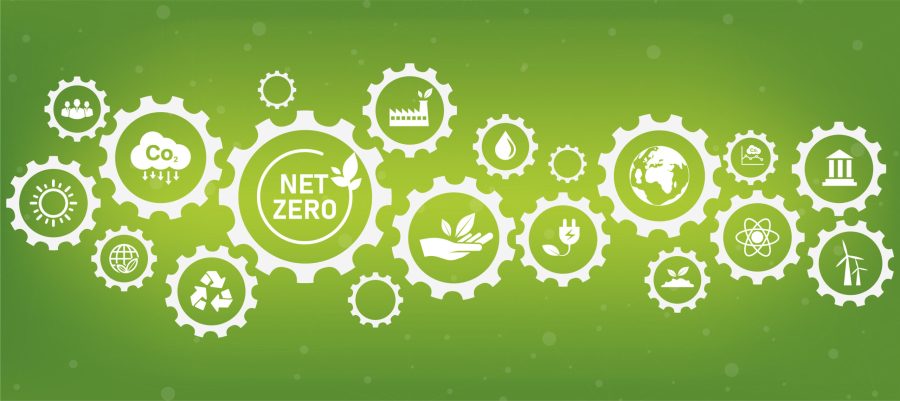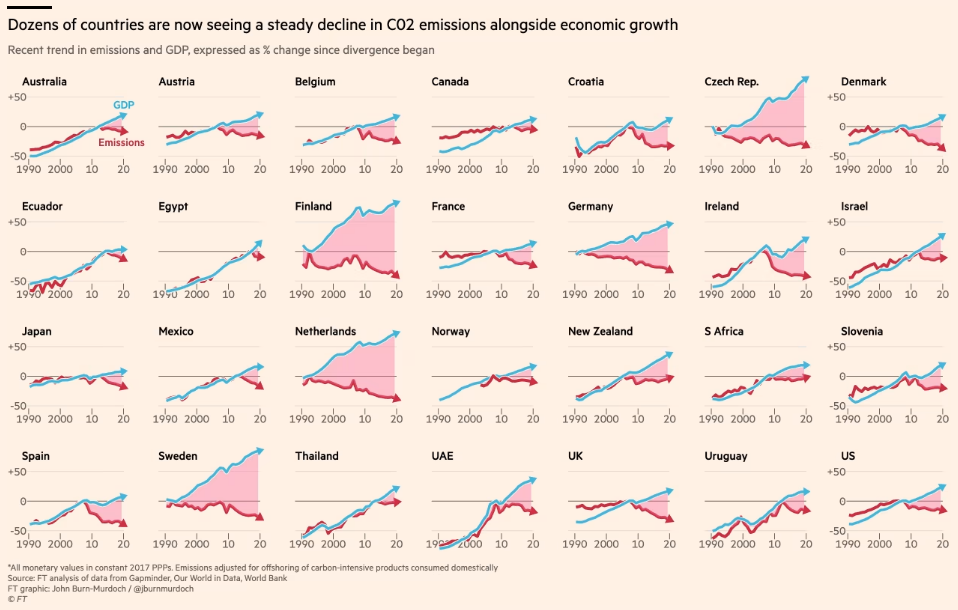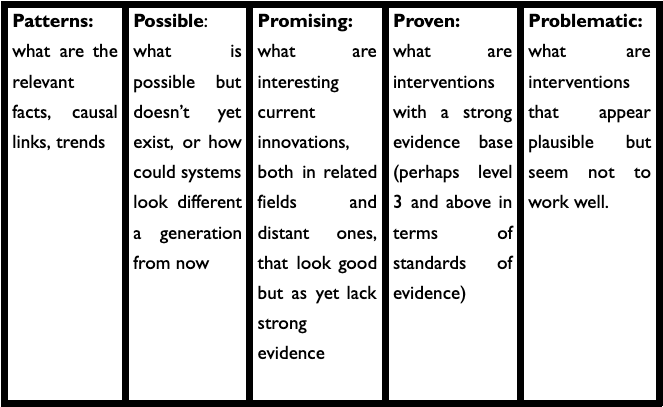Net Zero: Mobilising Knowledge for Easier, Effective Decision Making

Geoff Mulgan
The International Public Policy Observatory (@ippouk, covidandsociety.com) builds on many decades of experiment with ways to make complex knowledge useful and used, including programmes for evidence-based policy, What Works Centres, evidence syntheses, peer networks, collaboratives and much more.
This year one of IPPO’s areas of focus will be the Net Zero goal, a field that has prompted a vast amount of effort and innovation worldwide, from the IPCC to C40.
We will be working to connect the supply of evidence to demand from policymakers who need to know what works as they shape policies for retrofitting, transport, energy, buildings regulation, subsidies and taxes, reskilling and much else.
In this short note, I look at what already exists; how we might go about making the most of it; and how we can work with governments at multiple levels. It draws on over twenty years of experience working on decarbonisation strategies in both national governments and cities. The note ends with a description of a potential way of organising this ‘net zero knowledge commons’ to make knowledge as useful, used and dynamic as possible. The aim of this note is to generate inputs and ideas from others working in the space – and it will be updated periodically drawing on others’ inputs.
1. What Exists
The last few decades have seen an extraordinary amount of research and action around net zero, from small projects to retrofit homes to big ones introducing new energy sources; R&D programmes around batteries; scale ups of solar; big policy initiatives to shift useage, grow renewables and promote a more circular economy; and, within companies, ambitious programmes to cut waste and energy inputs in manufacturing and retail, data and transport.
As the chart compiled by the Financial Times below shows there is now plenty of evidence of the impact these have achieved, even though global emissions continue to rise and the world is on track to temperature rises far above the 1.5 degrees target.

Many repositories and sources try to make sense of this knowledge and experience. At a global level, these include the various surveys of the IPCC and others such as the Climate Policy Radar, Climate Action Tracker, UN Net Zero Coalition, and The C40 Knowledge Hub.
There are impressive targeted ones like this one on nature-based solutions, and very powerful more generic tools such as Elicit, which uses language models to help you automate research workflows.
There are resources focused on cities, including C40, and Bloomberg (Global) who have a Circular Cities Barometer alongside their Net Zero Pathfinders programme which includes examples of best practice for Cities.
Eurocities provide resources on climate change and energy transition framed as part of their focus area of “localising global challenges”. They also participate in the NetZeroCities project which is part of the EU’s Climate Neutral and Smart Cities Mission for Net Zero cities by 2030, and now works with 100 cities for which they are developing ClimateOS as a tool to help plan strategies:

The UK alone has many disparate sources including Carbon Hub, The Green Construction Board, Active Building Centre, Centre for Research into Energy Demand Solutions (CREDS), Smart Energy Research Lab, Energy Systems Catapult, Green Finance Institute, Coalition for the Energy Efficiency of Buildings (CEEB), Mission Innovation Heating and Cooling.
But the world still lacks an action equivalent to the core work of the IPCC. The IPCC focuses on diagnosis and very broad-brush strategy rather than evidence around specific policies and interventions.
Much of the knowledge about what works is still quite hard to access and assess – for example very few of the sources listed above tag examples with standardised measures of evidence reliability or cost-effectiveness (as is increasingly common in health and education). Yet this additional layer of knowledge can be vital for hard-pressed policy makers in cities and national governments.
2. Lessons on Evidence
Much has been learned about how to make evidence useful – and is relevant to the next phase of Net Zero.
First, just gathering evidence in repositories achieves relatively little. Such repositories tend to go unused. That’s why it’s important to focus as much on demand as supply, working with policy-makers and implementers to understand their needs and shaping any information to forms that work for them.
Second, we have learned that absorption of knowledge is hard (and that applies to all of us as individuals as well as to institutions). Without systematic attention to absorption, evidence will tend to go unused. That absorption can be helped by training, ‘scaffolding’ and professional development (as happens in medicine and to a lesser extent in some countries in fields like teaching and police); by devices like the collaboratives used in health which systematically drive improvement, innovation and peer learning and study circles (used in education to make the absorption of new evidence routine). But use of these methods is uneven in other fields, including most of those relevant to Net Zero.
Third, we’ve learned that people are most likely to listen to others like them. Doctors listen to doctors, teachers to teachers, police to police, engineers to engineers. So, any initiatives around knowledge about Net Zero need a strong horizontal, peer element – and thinking through the relevant communities of practice (e.g. transport planners, housing managers, regulators, builders etc).
Finally, a challenge with any kind of evidence is how to stay up-to-date, not just with new research but also changing facts, especially where new technologies are involved. This has prompted growing interest in ‘living synthesis’ instead of static synthesis and ‘living maps’ like this one from IPPO in 2021.

These are just a few of the lessons from the evidence about evidence, that can sometimes be troubling to anyone who hopes that just gathering evidence is enough to ensure it’s used.
3. What To Do?
What does this imply and what might we do differently in our next stage of work as we prioritise topics like net zero?
Supply
Let’s start with supply. Better supply is a necessary but not sufficient condition for impact. But it could be done better. We need better maps of where evidence is strong and where it is weak.
We hope to do this using access to open resources, through continuing to work with the EPPI-Centre which has an unmatched capability for complex evidence synthesis, drawing on millions of research sources and grey literature (an example of which is the IPPO systematic review on population mental health, published on 17 November).

We also have access to Elsevier’s data sources through our partnership with them, and have been experimenting with new ways of mapping the impact of research and patterns of how research is used in policy. This diagram is just one example of their extensive mapping of patterns of research, technology readiness and the position of different countries.
Their tools also helpfully keep abreast of technology maturity in different parts of the world, as show by these summary pictures on China and the US topic clusters around ‘net zero energy’:

There are also many tools to be used for web-scraping. Together these can help us build up maps that cover both availability of evidence and its reliability. How to visualise this complex information will be key as will the right search tools. Our hope is that there may be some important new ways to present complex information in ways that are easy to absorb. And we need some common ways of tagging knowledge, such as Nesta’s standards of evidence or technology readiness levels:


Demand
Then, we need a good sense of demand. What do policy-makers and others involved in implementation want? What are the key options being worked on?
In relation to policy some of the answers can be found quite easily through studying the various net-zero plans of national governments, devolved administrations and local authorities. They provide us a rough taxonomy which through conversation can then be prioritised. Overton also provides an excellent source for the more systematic mapping of policy priorities, and there are other relevant sources such as Policy Commons.
This is already a huge and complex landscape of different types of policy – from shifting electricity generation and distribution to use of data, hydrogen R&D to behaviour change, all with different timescales, mixes in terms of the roles of different tiers of government, and different boundaries with business.
An important task is to categorise these in useful ways.
Most politicians and policymakers are interested in emerging answers as well as mature ones. Indeed, the structure of what policymakers need to know roughly follows the five ‘Ps’:

These five dimensions of a field can be visualised as well as described. One option we are looking at is to create rooms that use walls to gather material about each of these dimensions, rather as control rooms function in a crisis, or police investigations gather relevant evidence and connections. Visualising – and embodying this knowledge – can make it easier to grasp, and easier to understand options.
At present, each strand is sometimes the job of different groups. There is, for example, little overlap between those doing evidence synthesis and others doing work mapping innovation. These are different communities using different methods – but it may be useful to link them together with some common language to describe the state of knowledge around different options.
Much of the evidence world focuses less on policy and more on professions and implementers – as NICE does for health, EEF for education and so on. Here the needs are different though related, so one crucial question is how to balance a focus on policy with a focus on frontline delivery and implementation.
4. Linking Demand and Supply
We can then work on overlaying these two maps of both supply and demand for evidence, in a rough matrix:

Our priority will be to work on the top two boxes, providing evidence syntheses where both demand and supply are strong, and providing advice on experiments and research strategies where demand is strong but supply is weak.
A key challenge is getting the categories right. For example, policy categories in relation to Net Zero might include:
- Advice to businesses/citizens on energy efficiency/reducing carbon footprint
- Encouraging/Incentivising behaviours and activities through initiatives like free or reduced public transport, subsidies for insulating homes
- Discouraging/De-incentivising carbon inefficient activities such as private car use through parking levees, or heavily pollutant vehicles through Low Emission Zones.
- Regulation: covering buildings (new and existing), manufacturing, products, transport, food and much more
- Tax: experience of differential taxes (eg cars) through to carbon taxes
- Skills: how to ensure adequate supply of skilled workers for tasks such as retrofitting
- Off-setting: for example, Indianapolis has committed to planting 30,000 trees by 2025
- Direct actions: for example, in public services (schools, hospitals etc) or cities switching to renewable sources of energy, switching to electric vehicles, and reducing energy use
- Research funding: how to allocate scarce R&D funds to different fields
- Industrial policy: orchestrating roadmaps linking R&D, diffusion, regulation, procurement etc
- Diplomacy/Advocacy nationally/internationally
5. Pathways and transitions
The more creative task is then to turn these into maps of pathways and transition routes. Here the evidence is likely to be inadequate because much will still be unknown. The interconnections between different policies are also likely to be complex.
There are many promising examples of roadmaps of this kind:
- Clean tech guide by IEA
- Carbon Dioxide Removal roadmap by Stripe
- Geochemical Negative Emissions Technologies review
- Ocean Based Carbon Dioxide Removal roadmap
- Roadmap to net-zero Buildings
- Roadmap for the bioeconomy
There are various platforms trying to bring together pathways, such as 2050pathways.
A key priority for governments will be to agree more detailed roadmaps, with the engagement of key stakeholders, primarily in business but also local authorities and others. These need to be sufficiently precise to allow for investment and planning (as has happened in the past with waste, electric cars and renewables), while offering flexibility as to how the goals will be met.
6. Net Zero Capabilities
Ideally, having analysed policy needs and the availability of evidence there would then be ways to connect these to maps of capabilities. Knowing what to do isn’t enough. We also need to know how to do it and if there are gaps in capabilities.
This is set to be a major challenge for net-zero plans which may be impressive in their aspirations – but without the structures, skills, processes and cultures needed to implement them.
A new EU programme on ‘Whole of Government’ innovation (which I am chairing) will include Net Zero as one of its areas of focus. It’s drawing on current work in various governments such as Austria, Finland and the Netherlands, and will involve looking at capacity gaps within key ministries (energy, transport, environment, finance), capacities in support and management of R&D, as well as agencies and regulators.
7. Making it all dynamic
We are also interested in how to make these orchestrations of evidence, needs and capabilities dynamic in two senses:
First, they need to become part of continuous conversations with the key decision-makers in cities, regional and national governments. Only through conversation, roundtables, and engagement can the evidence be refined to be more useful, and then adjusted and tailored to meet their needs. Just sending in large reports doesn’t work.
Second, they need to be dynamic in the sense of being continually updated. This is where the living syntheses become important: and the ‘living maps’ that IPPO developed.
These approaches are now being helped by greater use of machine learning and big data sets for real time learning. Radiant Earth is an interesting new venture doing this around global climate data (see this for example):

An example of this approach collects large quantities of data from buildings to spot emergent patterns and learn lessons in real time.

8. Politics and Opinion
For policymakers it’s vital to consider not just what needs to be done but also what will be legitimate, since many technically feasible options run up against politics and public opinion.
Here there is a growing body of evidence on how to frame policies, how to explain them and how to connect them to people’s everyday concerns, though again this tends to be organised quite separately from the technical analyses of net zero options.
We know that there are huge divergences between the perceptions of more urban, educated younger groups and older, more rural communities. We also know that many policies have backfired by failing to attend to their reception – from Australia’s carbon tax plans a decade ago to France’s fuel taxes which sparked the ‘gilets jaunes’. Interesting recent research confirmed the different framings needed in different contexts.
However, this knowledge perhaps lacks syntheses comparable to those available on the technical side.
9. Net Zero Knowledge Commons?
The many excellent sources of knowledge described so far in this paper tend to be discrete, bringing together material in their own terms. Even the best platforms are often presented as if they are stand-alone – without links to other platforms.
But what users of knowledge need is something more like a search function than a repository. A capacity for finding relevant information that is organised, so that for example if you search for urban retrofitting of old houses you can find:
- The technical research
- Policy examples
- Live innovations
- Evaluations and assessments – financial, behavioural
….all ranked and organised, ideally, according to reliability and then organised according to relevance (eg similar regions, types of city etc). This is a more complex task but one that may be needed to make the knowledge useful.
10. Next Steps
IPPO begins its next phase in January 2023, working in particular with the governments of the UK, Scotland, Wales, Northern Ireland as well as our cities and local authorities.
But the work we do will also be relevant to anyone grappling with decisions – and anyone who needs to know what is happening, what is being achieved and where there are potential alignments. These are likely to include each of the ‘Ps’ mentioned above, ranging from analysis of current patterns to experiments and pilots to scaling up of options with strong evidence.
Over the next few months we want to map out what is both achievable and useful, making the most of current resources and search tools, to make it easier for decision-makers at every level to act effectively.
This note aims to elicit responses and additions from others in the field and ideas on how best to make complex and messy knowledge useful and used. It has benefitted from inputs from Eirini Malliaraki and Jeremy Williams who I’ll be working with on fleshing this all out during 2023 as part of IPPO’s next phase.
If you’re interested in this work and would like to find out more, please email our Policy Evidence Lead: jeremy-williams@ucl.ac.uk
